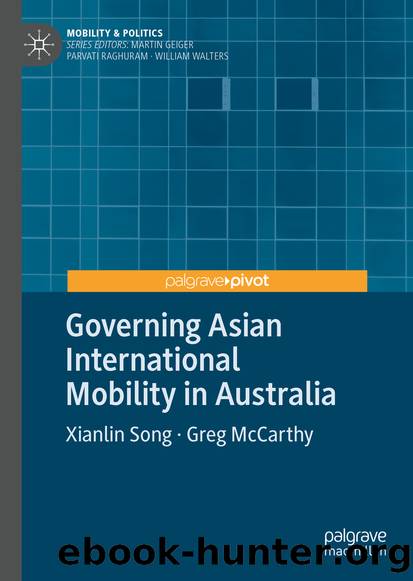Governing Asian International Mobility in Australia by Xianlin Song & Greg McCarthy

Author:Xianlin Song & Greg McCarthy
Language: eng
Format: epub
ISBN: 9783030241704
Publisher: Springer International Publishing
Higher Education Institutions and Asian International Students
As mentioned in Chap. 2, policymakers in the Australian higher education institution sector have embraced corporate style management techniques and practices, conforming to Foucault’s (1991) governmentality thesis, evident in such means as quality audits and accountability mechanisms that discipline academics to a neoliberal subjectivity, exemplified by systemic financial control measurement of education, right down to classroom practices and research outputs (Hil 2012; Marginson 2009, 2011, 2012; Rizvi and Lingard 2010; Saunders 2010). This is an agenda, overseen by the regulatory state and embedded in universities via a plethora of administrative departments and personnel, which apply the technologies of surveillance onto international students as mere customers with limited civil and social rights (Foucault 1991; Jayasuriya 2015; Nyland et al. 2013; Debets 2018). Notwithstanding the regulatory state’s role in treating overseas students in a differentiated manner, this has not hindered the global outflow of students, notably from China and India to Australia and to Anglophone countries, in general (Madge et al. 2015). In this mobility, what is evident is an ever-expanding overseas student demand for Australian higher education degrees, overwhelmingly from Asian countries. For example, Asian international students are highly prominent in the Australian enrolment data, with the top four countries, China (30 per cent), India (13 per cent), Nepal (6 per cent), and Malaysia (4 per cent) of the total 690,468 international students in Australia in November 2018 (DET 2018a).
In terms of national revenue generation over the past two decades, higher education has become a significant component of university funding and depicted as an export industry. For example, international student fee revenue earned by all Australian higher education providers totalled $7.6 billion in 2016 and $9.3 billion in 2017; with international student revenue in 2017, being the single largest source of revenue for public universities (Norton and Cherastidtham 2018, 45). This fee revenue has a three-fold multiplier effect, amounting to a total of $30.1 billion export earnings in 2017 (DET 2018b). In terms of income generation in the most populous state New South Wales , the NSW Auditor General’s Report (2018, 4) noted that overseas student revenue amounted to $2.8 billion for universities in that state and accounted for 28 per cent of total revenue of NSW universities. The report prompting concerns over the growing dependency on overseas funding for Australian universities (McGowan 2018). This concern had a country focus as, for example, one in four of all students enrolled at Sydney University—the state’s biggest tertiary institution—was Chinese. That share was more than one in five at the University of NSW and one in six at the University of Technology, Sydney (Wade 2018).
Whilst the dominant discourse of overseas students is economic rationalism, there is a deeper human side to the overseas student market. Notably, the geographically displaced Asian students confront both cultural and language learning differences, and despite considerable literature stressing cultural shock, readily adapt to their new academic and living environments (Gonzalez et al. 2001). However, substantial evidence indicates that a serious problem that
Download
This site does not store any files on its server. We only index and link to content provided by other sites. Please contact the content providers to delete copyright contents if any and email us, we'll remove relevant links or contents immediately.
Navigation and Map Reading by K Andrew(4553)
Spare by Prince Harry The Duke of Sussex(4195)
Tuesdays with Morrie by Mitch Albom(3832)
Cracking the GRE Premium Edition with 6 Practice Tests, 2015 (Graduate School Test Preparation) by Princeton Review(3596)
What It Really Takes to Get Into Ivy League and Other Highly Selective Colleges by Hughes Chuck(3220)
Goodbye Paradise(2961)
Never by Ken Follett(2880)
Pledged by Alexandra Robbins(2790)
Kick Ass in College: Highest Rated "How to Study in College" Book | 77 Ninja Study Skills Tips and Career Strategies | Motivational for College Students: A Guerrilla Guide to College Success by Fox Gunnar(2720)
A Dictionary of Sociology by Unknown(2518)
Graduate Admissions Essays, Fourth Edition: Write Your Way into the Graduate School of Your Choice (Graduate Admissions Essays: Write Your Way Into the) by Asher Donald(2474)
Sapiens and Homo Deus by Yuval Noah Harari(2414)
Get into Any College by Tanabe Gen Tanabe Kelly(2383)
Zero to Make by David Lang(2348)
The Social Psychology of Inequality by Unknown(2309)
Machine Learning at Scale with H2O by Gregory Keys | David Whiting(2289)
500 Must-Know AP Microeconomics/Macroeconomics Questions(2240)
Fairy Tale by Stephen King(2069)
Will by Will Smith(2041)
